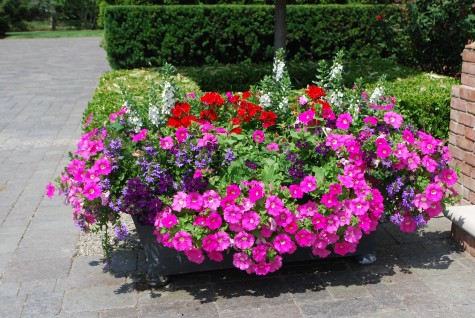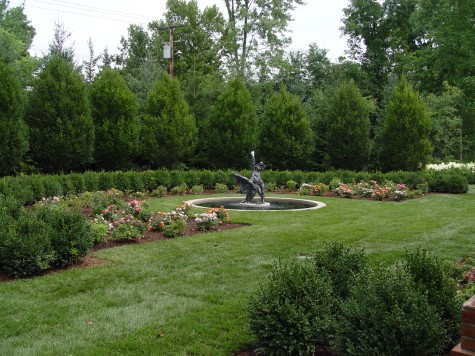
I knew from the start that the installation of this landscape would prove difficult. The property on the whole drains poorly at best. The soil is very heavy clay; parts of the property would hold water for weeks in the spring. It is not as if I were hoping for the best; an extensive drainage system was installed, and 1000 yards of soil added to bring the grade up. Faintly visible above the boxwood in this picture, one of many catch basins. The central landscape feature for the rear yard-14 very large columnar carpinus. By very large, I mean in excess of 25 feet tall. In front of those carpinus, densiformis yews and boxwood planted on a large radius. A rose garden and fountain completed this center portion of the landscape.
 On either side of this center section, simple lawn panels edged in boxwood. At the far ends, a pair of herbaceous borders on both sides of the lawn. The wild landscape in the background would be left as is, although there were a number of ash trees dead and dying which had to come down.
On either side of this center section, simple lawn panels edged in boxwood. At the far ends, a pair of herbaceous borders on both sides of the lawn. The wild landscape in the background would be left as is, although there were a number of ash trees dead and dying which had to come down.
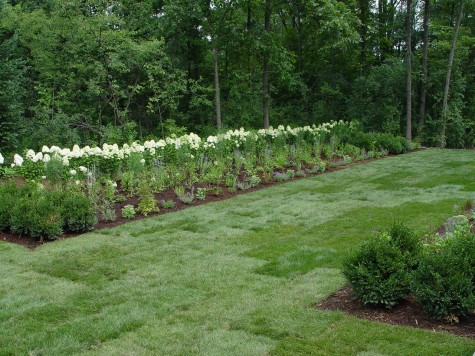 The perennial gardens are backed up by a long hedge of Limelight hydrangea. The perennial border were planted with Russian sage, boltonia, peonies, Siberian iris, Shasta daisies, coneflowers-all the usual suspects. I was interested in those perennials that are fairly easy to grow, and lots of them. I did plant the perennials alternating; that meadowy look would pair well with that untouched wild background.
The perennial gardens are backed up by a long hedge of Limelight hydrangea. The perennial border were planted with Russian sage, boltonia, peonies, Siberian iris, Shasta daisies, coneflowers-all the usual suspects. I was interested in those perennials that are fairly easy to grow, and lots of them. I did plant the perennials alternating; that meadowy look would pair well with that untouched wild background.
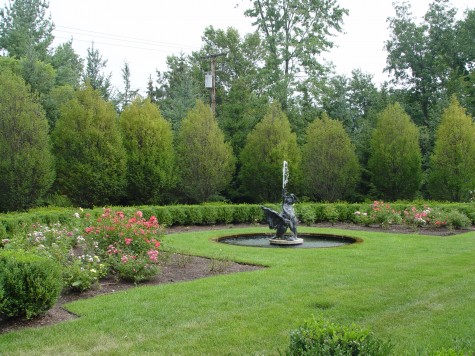 Within a year, the carpinus had begun to show definite signs of water stress. Roses and perennials, going into the winter soaking wet, died. I suspected that the irrigation system was pumping as much water to all of the beds as it was to the lawn. Once woody plant material is established, its need for water declines. I was by no means thrilled with how the irrigation system had been designed, but it was what I had to work with. The lawn looked fine-the landscape did not.
Within a year, the carpinus had begun to show definite signs of water stress. Roses and perennials, going into the winter soaking wet, died. I suspected that the irrigation system was pumping as much water to all of the beds as it was to the lawn. Once woody plant material is established, its need for water declines. I was by no means thrilled with how the irrigation system had been designed, but it was what I had to work with. The lawn looked fine-the landscape did not.
 By the third year, there was no mistaking that the trees were not going to tolerate the level of water they were getting. Added to that, some hard late spring frosts with below freezing temperatures for 4 days in a row. There were lots of leaf buds damaged or destroyed. My client was alarmed by what she saw. I told her there was no giving up on the trees. We no longer had access to the rear yard to plant trees. She was going to have to grow them out. My client is a very decisive individual. She turned the irrigation off, and locked the box. The lawn was irrigated as little as possible, and definitely not on any regular schedule.
By the third year, there was no mistaking that the trees were not going to tolerate the level of water they were getting. Added to that, some hard late spring frosts with below freezing temperatures for 4 days in a row. There were lots of leaf buds damaged or destroyed. My client was alarmed by what she saw. I told her there was no giving up on the trees. We no longer had access to the rear yard to plant trees. She was going to have to grow them out. My client is a very decisive individual. She turned the irrigation off, and locked the box. The lawn was irrigated as little as possible, and definitely not on any regular schedule.
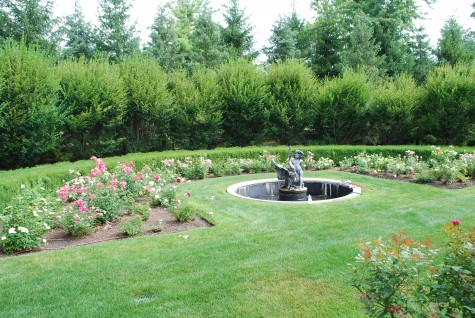 5 years later, the carpinus have made quite the comeback, and are growing vigorously. They only get water when it rains. All of the woody plant material has stabilized. It can be very difficult to establish a landscape on clay, but once it is established it is very long lived-unless you overwater. Enough water to live, and enough water to drown can be close to the same amount. Once you see the foliage on woody plants start to yellow, check the water first.
5 years later, the carpinus have made quite the comeback, and are growing vigorously. They only get water when it rains. All of the woody plant material has stabilized. It can be very difficult to establish a landscape on clay, but once it is established it is very long lived-unless you overwater. Enough water to live, and enough water to drown can be close to the same amount. Once you see the foliage on woody plants start to yellow, check the water first.
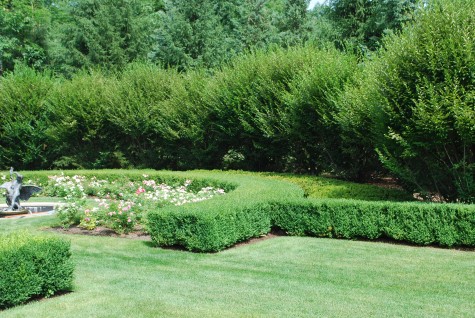 Even the yews behind the boxwood have stabilized If you are wondering how it is possible for it to be shorter than the boxwood-the deer keep it pruned like this. I am amazed at how level a job they do, chewing.
Even the yews behind the boxwood have stabilized If you are wondering how it is possible for it to be shorter than the boxwood-the deer keep it pruned like this. I am amazed at how level a job they do, chewing.
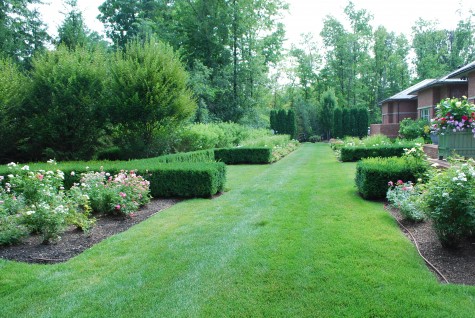 The lawn has spots that look like they could use a little water, but a sustainable equilibrium here is more important than a perfect lawn. The foliage color of every plant is exactly as it should be. M and M maintains this landscape; Mindy keeps a sharp eye out for any sign of too much water. It has taken 6 years to get this landscape to thrive as it should.
The lawn has spots that look like they could use a little water, but a sustainable equilibrium here is more important than a perfect lawn. The foliage color of every plant is exactly as it should be. M and M maintains this landscape; Mindy keeps a sharp eye out for any sign of too much water. It has taken 6 years to get this landscape to thrive as it should.
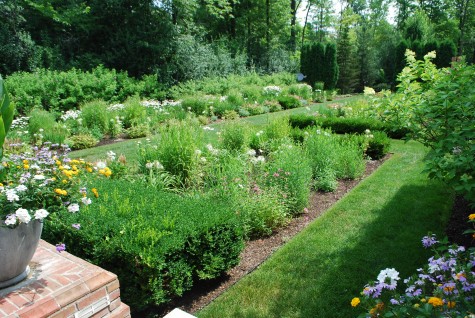 Even the perennials have put on size. I find it very easy to get perennials planted in sandy soil to take hold, but it is so hard to keep them thriving. The only solution there is to add organic material to the soil and mulch every chance you get. Perennial bark fines add a lot of organic material to the soil, when it decomposes. Once perennials are well established on clay, they can live a long time.
Even the perennials have put on size. I find it very easy to get perennials planted in sandy soil to take hold, but it is so hard to keep them thriving. The only solution there is to add organic material to the soil and mulch every chance you get. Perennial bark fines add a lot of organic material to the soil, when it decomposes. Once perennials are well established on clay, they can live a long time.
 We have the watering on the pots down as well. One of the reasons I so enjoy container gardening is my option to pick the soil, and supply adequate drainage. My experience planting indicates that attempting to radically change the composition of native soil is futile. I plant trees that like wet feet in very heavy soils; I have success with evergreens and lavender on sandy based well drained soils. I almost never plant rhododendron-our soil is very heavy and alkaline, not acid and compost based. But the pots are different-I get to pick the soil. These yellow cannas are beginning to spike; they have had enough hot weather and regular watering to flower.
We have the watering on the pots down as well. One of the reasons I so enjoy container gardening is my option to pick the soil, and supply adequate drainage. My experience planting indicates that attempting to radically change the composition of native soil is futile. I plant trees that like wet feet in very heavy soils; I have success with evergreens and lavender on sandy based well drained soils. I almost never plant rhododendron-our soil is very heavy and alkaline, not acid and compost based. But the pots are different-I get to pick the soil. These yellow cannas are beginning to spike; they have had enough hot weather and regular watering to flower.
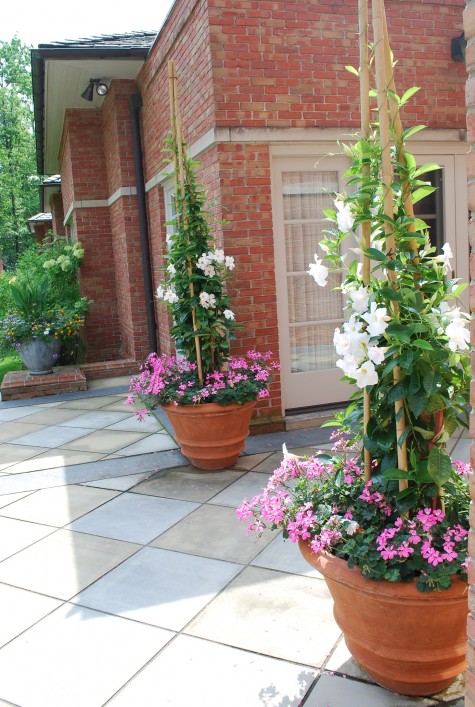 This is a much happier garden than it was 6 years ago. As Jennifer commented yesterday, a gardener is a person who is in it for the long haul. These pot planting only last one season. I like that. I can start over, and do better next year. But a landscape is a committment that needs looking after, year after year.
This is a much happier garden than it was 6 years ago. As Jennifer commented yesterday, a gardener is a person who is in it for the long haul. These pot planting only last one season. I like that. I can start over, and do better next year. But a landscape is a committment that needs looking after, year after year.
